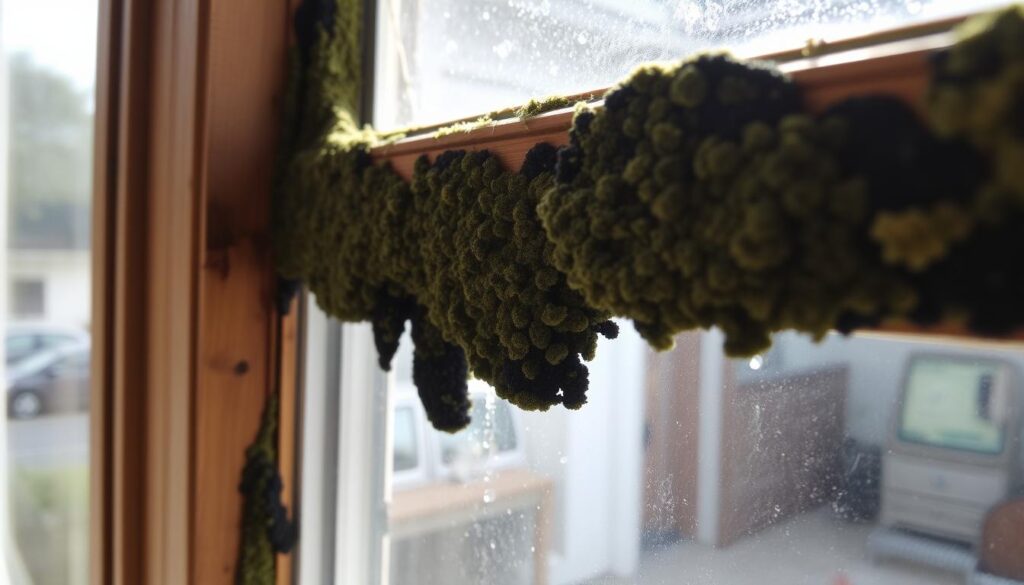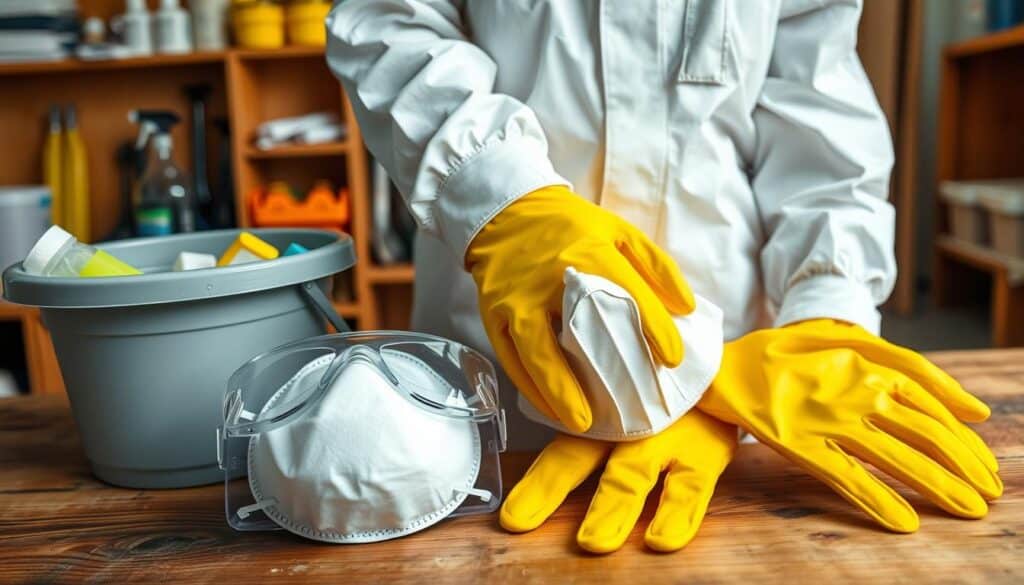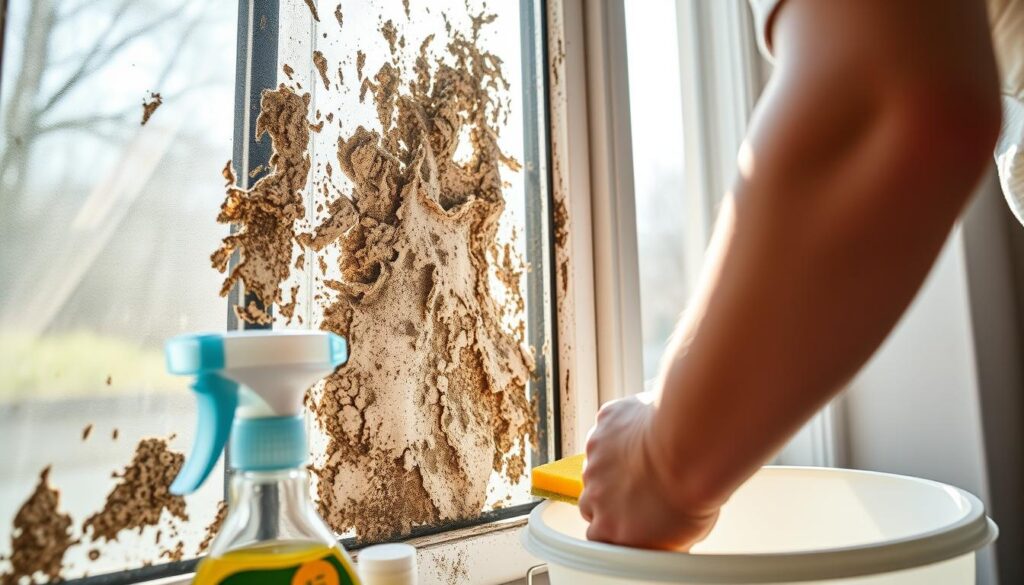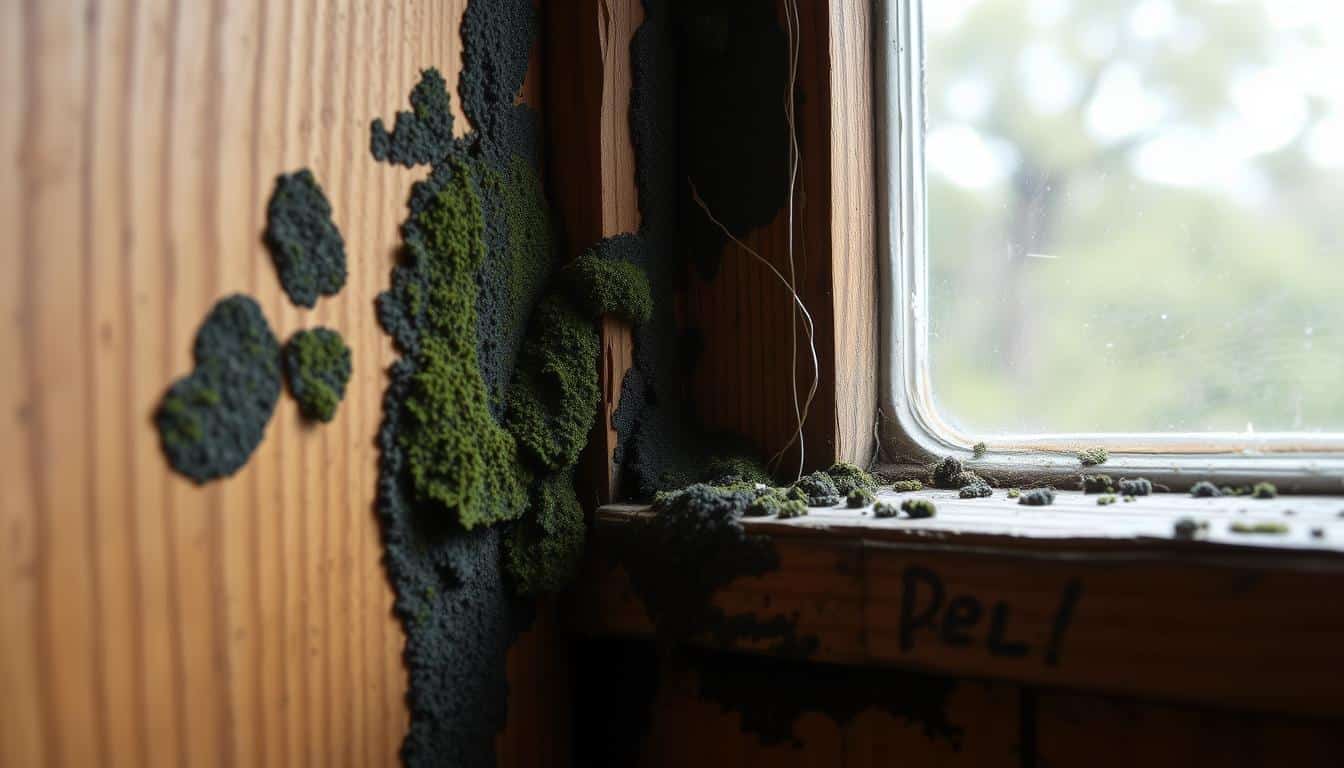Mold can be a big problem, especially on window sills and frames. Did you know 37% of homes in the U.S. have indoor mold? This shows how common it is and why we need to act fast.
I care about clean air and a healthy home. So, I’ve found ways to safely remove mold from windows. In this article, I’ll show you a simple, two-step method to make your windows mold-free.
Key Takeaways
- Mold loves damp, humid places, making window sills and frames a perfect spot for it to grow.
- Wearing protective gear and using dry cloths are key first steps in removing mold.
- Natural cleaners like vinegar, baking soda, and tea tree oil can kill mold effectively.
- Throwing away moldy stuff and keeping your home dry are important to stop mold from coming back.
- If you have a lot of mold, you might need to call a professional mold removal service.
Understanding the Causes and Types of Mold on Windows
Mold can be a big problem on windows, especially in humid places like Florida. It’s important to know why it happens and what kinds of mold you might see.
Environmental Factors Contributing to Mold Growth
Mold loves moist places, and windows are often wet. This is because of condensation, bad ventilation, and high humidity. Also, dust, pollen, and dead bugs can feed mold.
Common Indoor Mold Varieties and Their Effects
There are many kinds of mold that can grow on windows. Some, like Cladosporium and Penicillium, can make you sneeze. But others, like Aspergillus and Stachybotrys, can be very dangerous. They can cause serious breathing problems and weaken your immune system.
| Mold Type | Potential Health Effects |
|---|---|
| Cladosporium | Mild allergic reactions, respiratory issues |
| Penicillium | Allergic reactions, immune system suppression |
| Aspergillus | Serious respiratory problems, lung infections |
| Stachybotrys (Black Mold) | Severe respiratory issues, immune system damage |
To fight mold, you need to know why it grows and what types there are. By fixing the environment and knowing the mold, you can keep your windows clean and free of mold.

Preparing for Mold Removal: Necessary Gear and Supplies
Before you start removing mold from window frames, make sure you have the right gear and supplies. Safety is key when dealing with mold. It can cause breathing problems, skin irritation, and allergic reactions.
Wear rubber gloves, safety goggles, and a face mask or respirator to stay safe. These protective equipment for mold removal help block mold spores. Also, wear disposable clothes that you can throw away after cleaning.
For cleaning, you’ll need white vinegar, hydrogen peroxide, baking soda, and a strong scrubbing brush. These natural mold cleaning products are good at killing mold without harsh chemicals.
It’s also important to dispose of contaminated items properly. Put all disposable cleaning cloths and waste in a sealed bag. This stops mold spores from spreading. With the right gear and supplies, you can safely and effectively remove mold from your window frames.

| Protective Equipment | Cleaning Supplies |
|---|---|
| Rubber gloves | White vinegar |
| Safety goggles | Hydrogen peroxide |
| Face mask or respirator | Baking soda |
| Disposable clothing | Scrubbing brush |
Step-by-Step Guide to Removing Mold from Window Frames
Removing mold from window frames needs a careful and effective plan. First, use a dry wipe to get rid of extra mold. Then, apply natural cleaning solutions. Make sure to dampen the area with water first to stop mold spores from spreading. After that, gently wipe the surface with a dry, disposable cloth.
Dry Wipe and Pre-Treatment
Begin by wiping away any visible mold on the window frame with a dry, disposable cloth. This method keeps mold spores from flying around. After removing the excess mold, you can move on to deep cleaning with natural solutions.
Natural Cleaning Solutions: Vinegar, Baking Soda, and Tea Tree Oil
For deep cleaning, use natural solutions that kill mold. White vinegar, undiluted, can kill up to 82% of mold species. You can also mix baking soda with water or use hydrogen peroxide. Tea tree oil has antifungal properties and can be part of your cleaning routine.
Put the chosen cleaning solution on the moldy area, making sure it’s fully covered. Let it sit for the time suggested before wiping it clean and letting it dry. If needed, repeat the process until all mold is gone.

Always wear gloves, a mask, and eye protection when removing mold. By following these steps, you can remove mold from your window frames and keep it from coming back.
How Do You Remove Mold from Window Frames: Tackling Specific Materials
Removing mold from window frames depends on the material. We’ll look at the best ways to clean mold from wood, vinyl, glass, and aluminum.
Cleaning Mold from Wood and Vinyl Window Frames
Wood and vinyl frames should not be exposed to harsh chemicals. Use a vinegar and water mix instead. This solution is gentle yet effective.
Apply the vinegar solution with a soft-bristled brush. The acid in vinegar kills mold. Rinse with clean water and dry well.
For tough mold, try a baking soda paste. Scrub it on, let it sit, then rinse. Baking soda is gentle yet effective.
Removing Mold from Glass and Aluminum Window Components
On glass and aluminum, vinegar or baking soda solutions work well. Apply, let sit, then scrub with a soft brush. These solutions kill mold without harm.
For hard-to-remove mold, add tea tree oil to your solution. It’s a natural antifungal.
Choosing the right cleaning method is key. Vinegar, baking soda, and tea tree oil are safe and effective.
Dealing with Black Mold: Identifying and Removing Safely
Black mold, also known as Stachybotrys chartarum, is a dangerous indoor mold. It can cause serious health issues because of the toxic mycotoxins it makes. Black mold might not grow on window sills but can hide in areas like wall cavities around windows.
If you think you have black mold, getting professional help is key. It’s dangerous to breathe in black mold spores. They can lead to breathing problems and other health issues.
Identifying Black Mold
Finding black mold can be hard because it might not always look black or grey. Look for these signs:
- Discoloration on walls, ceilings, or window frames
- A musty, earthy smell in the area
- Visible growth, often slimy or velvety
If you’re not sure, get a professional mold inspection. They can tell you what mold you have and how big the problem is.
Safely Removing Black Mold
Trying to remove black mold yourself can be risky. It’s safer to get a professional mold remediation contractor, especially for big areas. They have the right tools and know-how to safely remove mold and protect you.
When dealing with black mold, always wear protective gear. This includes a N95 respirator mask, goggles, and gloves. Don’t disturb the mold to avoid spreading spores. Instead, fix the moisture problem that’s causing the mold.
Good ventilation, dehumidification, and regular upkeep are key to stop black mold. By acting fast and taking care of mold problems, you can keep your home safe and healthy.
Post-Cleaning Steps and Preventative Measures
After removing mold from your window frames, drying and dehumidifying the area is key. This stops mold from coming back. Use a dehumidifier and open windows often to control humidity and fix moisture issues.
Drying and Dehumidifying the Area
After cleaning, dry the affected areas well. A dehumidifier helps keep humidity below 50%. Open windows and use fans to help dry the area.
Controlling Indoor Humidity and Improving Ventilation
Excess moisture and poor air flow lead to mold. Check your home’s humidity often. Use a dehumidifier to keep it right.
Open windows and use fans to improve air flow. This is especially important in wet areas like bathrooms and kitchens.
Regularly check your windows for mold. Clean them often to keep them mold-free.
By following these steps, you can dry out mold-affected areas, dehumidify to prevent mold, improve indoor ventilation, and maintain mold-free windows for good.
When to Seek Professional Mold Remediation Services
If you have a big mold problem on your window frames, or think you might have toxic black mold elsewhere, call the pros. They can figure out what kind of mold you have, how big the problem is, and safely get rid of it. They use special tools and methods to keep things clean.
Mold around windows, especially on wood, can be bad. It can have harmful molds like black mold, Cladosporium, and Penicillium. These molds can make you sick if you breathe in their spores.
Mold spores can make health problems worse, especially for people with allergies or asthma. If you have mold allergies or asthma, being around mold can make your symptoms much worse. Signs of mold sickness include wheezing, sneezing, and coughing.
Getting rid of mold on wooden windowsills can be tough. That’s why you should get help from mold removal experts. They can make sure the mold is gone for good and keep you safe from health risks.
Mold Busters offers fast scheduling for mold removal services, often within 24 hours of contact, and same-day reports and estimates to address urgent mold issues promptly.
Mold on window frames is common in damp places. It looks like black or green spots and can spread fast. If you don’t get rid of it, it can damage the surface and cost a lot to fix or replace.
Stachybotrys is the third most common toxic mold type found in homes tested in the Montreal and Ottawa areas, emphasizing the importance of professional mold removal services.
Maintaining Clean and Mold-Free Window Frames
Keeping your window frames clean and mold-free needs constant effort. Regular window cleaning stops mold from growing and keeps your home healthy. Watch for mold and fix any moisture or air issues fast to stop mold from coming back.
Mold can grow and spread quickly, forming large colonies in just 48 hours. Toxic black mold is especially harmful, causing health problems. Breathing in mold spores can lead to allergies, including skin issues, runny nose, and coughing.
To keep your window frames clean and mold-free, follow these steps:
- Wipe down window frames and sills once a month with a microfiber cloth and mild vinegar solution.
- Check window frames and sills often for mold signs like discoloration or fuzzy spots.
- Fix any moisture or air problems right away since mold loves damp places.
- Keep your home at 70°F or lower to stop mold on window sills.
- Get professional help for big mold problems or if you think you have toxic black mold.
By regularly cleaning, monitoring for mold, and preventing future mold growth, you can keep your window frames looking good. This also makes sure your home is a healthy place for your family.
Conclusion
To remove mold from window frames, I need to follow a few steps. First, I wear protective gear. Then, I use natural cleaning solutions. Finally, I dispose of any contaminated materials properly.
It’s important to fix the reasons mold grows, like too much moisture and bad air flow. I check my windows and frames often for mold. I also work to keep the air in my home dry.
Keeping my window frames clean is key for good air quality. Healthy indoor air is essential. By being careful and proactive, I can keep my home mold-free and comfortable for everyone.
FAQ
What are the common causes of mold growth on window frames?
Mold grows on window frames because of high humidity and condensation. Dirt or debris also helps mold grow by providing nutrients.
What are the different types of indoor mold and their effects on health?
Indoor mold includes allergenic, pathogenic, and toxigenic types. Allergenic molds cause mild reactions. Pathogenic and toxigenic molds, like black mold, can lead to serious health issues.
What protective gear should I use when removing mold from window frames?
Wear rubber gloves, a mask, and goggles to protect yourself from mold spores. This ensures safe handling of contaminated materials.
What natural cleaning solutions can I use to effectively remove mold from window frames?
Use undiluted white vinegar, a baking soda and water solution, or tea tree oil. These natural cleaners have antifungal properties.
How do I properly dispose of mold-contaminated materials?
Seal contaminated materials, like used cloths, in a plastic bag. Dispose of them properly to prevent mold spore spread.
How do I remove mold from different types of window frame materials?
Cleaning methods vary by material. Vinegar works well on glass and aluminum. Wood and vinyl frames need gentler methods to avoid damage.
How do I identify and safely remove black mold from around my windows?
Black mold, or Stachybotrys chartarum, is dangerous. If you suspect it, get professional help. The spores are hazardous to inhale.
What steps should I take to prevent future mold growth on my window frames?
Keep your home dehumidified and well-ventilated. Fix moisture issues and clean your window frames regularly to prevent mold.
When should I consider hiring professional mold remediation services?
Hire professionals for extensive mold problems or if you suspect toxic black mold. They can safely identify and remove it.




